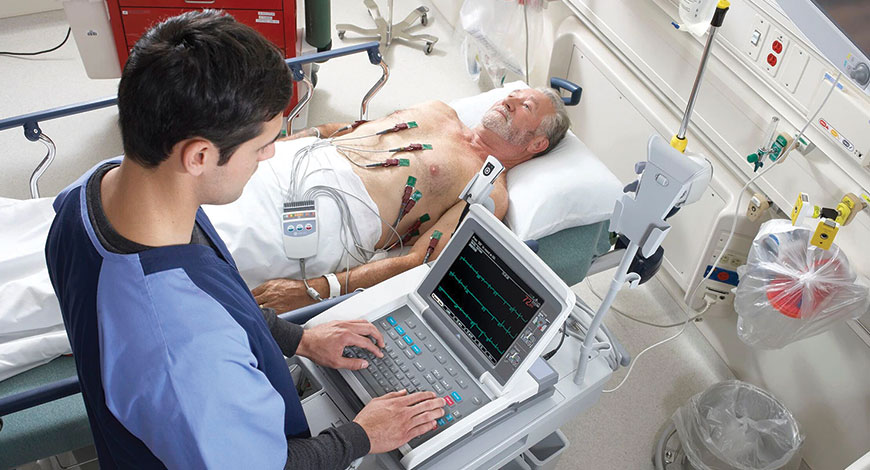ECG Equipment
A glance at the latest advances in cardiac monitoring

The resting ECG has been used as a basic cardiac diagnostic for a century, and while the premise remains the same, testing systems are evolving to meet today’s technology demands.
The biggest advancement in ECG systems in recent years has been the movement to greater interoperability and digital formats. But other technologies are beginning to be integrated into ECG systems, such as aids to properly place leads, Artificial Intelligence, Machine Learning, and a ways to extract additional information from ECGs to increase diagnostic value.
Some of the recent trends in these newer ECG systems include:
Digital formats. In the past decade, ECG systems have moved from technology that was largely not compatible with different vendors’ cardiology reporting systems or electronic medical record (EMR) systems. The main focus of older generation systems was on a paper printout, but today’s systems now require easy IT interface, compatibility, and digitally stored waveforms to be compatible with increasingly paperless hospitals that use the EMR to access patient reports and data such as ECGs.
The movement to digital formats has allowed the use of digital calipers and waveform analysis algorithms. It also enables electronic storage and communications of the data with the patient’s electronic medical record. Automation to help speed the reading the waveforms and report on them is also offered by some vendors. Digital ECG management and reporting systems also have become standard features on all cardiovascular information systems (CVIS). For this reason, many ECG systems and ECG management systems now offer vendor-agnostic integration with other vendors’ ECG system data.
Many of the major vendors in the ECG market sell multiple types of systems that are aimed at different markets, from smaller and less sophisticated versions, to premium systems. This is to address the different needs of a large, busy, urban hospital which are not the same as those of physician offices or small remote sites.
Mobile access to waveforms. Several vendors have added smartphone interoperability to their systems, so ECG waveforms can be sent for immediate review by a physician, regardless of where they are. This has had a particular impact on emergency patient evaluations, such as those presenting to the emergency department with chest pain or suspected ST-elevated myocardial infarction (STEMI).
The rapid diagnosis on smartphones enables earlier activation in the catheterization lab, leading to better patient outcomes in STEMI cases. The technology is especially helpful to connect with cardiologists who are not near an ECG system workstation or are at home in off-hours. Several vendors now allow dynamic ECG waveforms to be displayed on an iPad for remote access to either read studies outside traditional workstations or for faster access to confirm suspected STEMI cases.
 Dr Vanita Arora
Dr Vanita Arora
Senior Consultant Cardiac,
Max Healthcare
“The increase in prevalence of cardiac arrhythmia and CVDs are believed to drive Indian ECG equipment market. The change from acute intervention in the clinical setting to preventive care has supported the growth of ECG diagnostic care market significantly. An early diagnosis for targeted treatment is the need of the hour, which the ECG device can help with. The ECG gadgets market has seen a few mechanical progressions, which have diminished the size, upgraded transportability, and improved on the utilization of ECG gadgets. Innovative headways in sensors (plethysmography) have empowered the improvement of wearable gadgets that can screen and record cardiac signals. Such gadgets can be utilized without ordinary ECG machines in out of hospital emergency and public spots. The efficiency of handheld, remote, and wrist watch ECG gadgets will be one of the basic ECG gadget market patterns answerable for the development of the market in coming years”
Lead placement assistance. Improper lead placement in clinics and offices can be an issue leading to poor ECGs. Schiller offers a solution to this issue with its Cardiovit FT-1 ECG system. It has a 3-D rendering of a patient on the device’s screen, which shows where each lead needs to be placed. The user can rotate the images on the touch screen to see where the leads go and can easily identify where any issues are when the system automatically alerts them about misplaced leads. The goal is to improve the speed and accuracy of ECGs using a better form of visualization than the traditional black and white 2-D pictures. The system changes the lead placements of the body rendering based on the type of exam being performed using a drop down menu.
AI and ECG. Like many facets of healthcare, Artificial Intelligence (AI) is being developed to aid ECG interpretation. AI can examine ECG waveforms to pinpoint patients at higher risk of developing a potentially dangerous arrhythmia or of dying within the next year. The AI can take a deeper dive to extract more information out of the waveforms that may not be apparent, even for an experienced reader. Several such studies have been presented at the American Heart Association (AHA) meeting over the past two years and published in cardiology journals. These types of algorithms will likely be seen appearing as options on the next generations of ECG systems.
ML and ECG. Since the advent of digital ECG machines in the 1960s, ML has been used in ECG data processing and reporting under the guise of computer-interpreted electrocardiograms (CIE). With modern ML methods, ECG interpretation algorithms have improved in accuracy, reliability, and efficiency when compared with traditional CIE. Recent advancements in ML technologies allow for diverse applications of ML algorithms to improve technical quality assurance, arrhythmia identification, prognostic predictions, and other functionalities. At the present time, routine ECG processing and interpretation still experience numerous technical deficiencies, including weak signal and disturbance from noise. To overcome these problems, low pass, high pass, and Butterworth filters are used to preprocess ECG data for subsequent ML analysis. Mathematical wavelet transform approaches have been increasingly used to increase signal robustness compared with noise, so as to better define the features of ECG waves. Using SVM methods, ECG ML algorithms have significantly improved reliability attaining accuracies in sinus rhythm, left bundle branch block, right bundle branch block, premature ventricular contraction, and premature atrial contraction. Research is ongoing to standardize and validate these methods before their routine clinical application.
An ECG on wrist. In the past 5 years, there has been an explosion in wearable and handheld ECG enabled devices and smartphone apps that allow anyone to record a 1-6 lead ECG. There also has been a lot of interest by cardiologists in these systems. These systems are seen as a fast and easy way to better triage patients and get immediate information before sending a patient for more involved exams.
Regulatory approval and technological advances are making it easier for people to continuously monitor their hearts with wearable devices. Fitness trackers are not serious medical devices. An intense workout or loose band can mess with the sensors that read pulse. But an electrocardiogram—the kind doctors use to diagnose abnormalities before they cause a stroke or heart attack— require a visit to a clinic, and people often fail to take the test in time.
ECG-enabled smart watches, made possible by new regulations and innovations in hardware and software, offer the convenience of a wearable device with something closer to the precision of a medical one.
An Apple Watch–compatible band from Silicon Valley startup AliveCor that can detect atrial fibrillation, a frequent cause of blood clots and stroke, received clearance from the FDA in 2017. Last year, Apple released its own FDA-cleared ECG feature, embedded in the watch itself.
The health-device company Withings also announced plans for an ECG-equipped watch shortly after.
Current wearables still employ only a single sensor, whereas a real ECG has 12. And no wearable can yet detect a heart attack as it is happening.
But this might change soon. Last fall, AliveCor presented preliminary results to the American Heart Association on an app and two-sensor system that can detect a certain type of heart attack.
Much effort has been made to integrate ECG and echocardiography interpretation into an automated framework, improve the quality of disease diagnosis and risk stratification, and support clinical decision making. Improved reading effectiveness and efficiency will potentially contribute to addressing the supply-demand mismatch in current cardiovascular healthcare systems.
In the coming years, all of these types of ECG data will likely need to be integrated into ECG management systems to allow for a complete picture of the patient’s cardiac history. Now that the technology exists and is proliferating, the question is how and where to integrate this data into the patient record.











